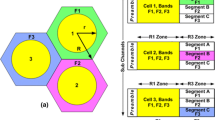Abstract
The WiMAX (IEEE 802.16e-2005) standard supports fractional frequency reuse concept. To implement this idea, the WiMAX standard has proposed the concept of zones where different frequency reuse factors (FRFs) are employed. Here, each cell/cluster operates with multiple zones where different FRFs are used. The zone of operation for each user can be either permanently fixed or determined dynamically. The dynamic assignment of the zone can potentially utilize the bandwidth efficiently and improve the system throughput. Dynamic zone selection schemes based on the two metrics namely radio distance and bandwidth efficiency are proposed in this paper. The impact of the dynamic zone selection scheme on throughput is studied and compared with the fixed reuse zone schemes.
Similar content being viewed by others
References
IEEE 802.16d. (2004). IEEE standard for local and metropolitan area networks—part 16: air interface for fixed broadband wireless access systems.
IEEE Standard 802.16e. (2005). Air interface for fixed and mobile broadband wireless access systems.
Hoymann C. (2005) Analysis and performance evaluation of the OFDM-based metropolitan area network IEEE 802.16. Computer Networks 49: 341–363
Ball, C. F., Humburg, E., Ivanov, K., & Müllner, R. (2005). Rapid estimation method for data capacity and spectrum efficiency in cellular networks. In Proceeding of IST mobile and wireless summit.
Riato, N., Serrelli, F., Sala, A., & Capone, A. (2007). Interference mitigation strategies for WiMAX networks. In International symposium on wireless communication systems (pp. 175–179).
Ball, C. F., & Ivanov, K. (2005). Spectrum efficiency evaluation for different wireless technologies based on traffic modeling. In IEEE International symposium on personal, indoor and mobile radio communications (Vol. 3, pp. 2055–2061).
Ball C.F., Treml F., Ivanov K., Humburg E. (2006) Performance evaluation of IEEE 802.16 WiMAX with fixed and mobile subscribers in tight reuse. European Transactions on Telecommunications 17(1): 203–218
Ferneke, A., Klein, A., Wegmann, B., Dietrich, K., & Humburg, H. (2007). Performance of IEEE 802.16e OFDMA in tight reuse scenarios. In IEEE international symposium on personal, indoor and mobile radio communications (pp. 1–5).
Necker, M. C. (2007). Coordinated Fractional Frequency Reuse. In Proceedings of ACM symposium on modeling, analysis, and simulation of wireless and mobile systems (pp. 296–305).
Zhou, Y., & Zein, N. (2008). Simulation study of fractional frequency reuse for mobile WiMAX. In Proceedings of IEEE vehicular technology conference (pp. 2592–2595).
Author information
Authors and Affiliations
Corresponding author
Rights and permissions
About this article
Cite this article
Jackson Juliet Roy, J., Vaidehi, V. Analysis of Frequency Reuse and Throughput Enhancement in WiMAX Systems. Wireless Pers Commun 61, 1–17 (2011). https://doi.org/10.1007/s11277-010-9995-6
Published:
Issue Date:
DOI: https://doi.org/10.1007/s11277-010-9995-6




